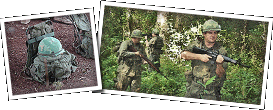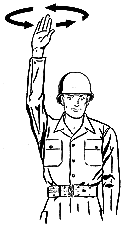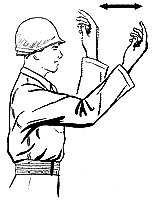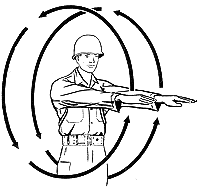Infantry Specific hand signals from
Visual Signals
FM 21-60, December 1966
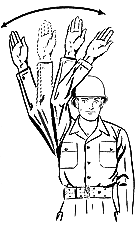 |
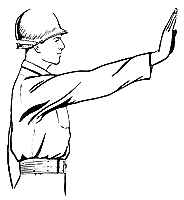 |
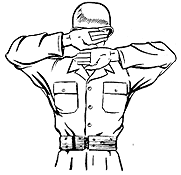 |
| ATTENTION. Extend the arm sideways, slightly above horizontal, palm to the front; wave arm to and away from the head several times. | I AM READY or ARE YOU READY? Extend the arm toward the person being signaled; then raise arm slightly above horizontal, palm facing outward. | I DO NOT UNDERSTAND. Raise both arms sidewards to the horizontal; bend both arms at elbows and place both hands across the face, palms to the front. |
 |
|
|
| DISREGARD PREVIOUS COMMAND or AS YOU WERE. Raise both arms and cross them over the head, palms to the front. | ASSEMBLE or RALLY. Raise the arm vertically overhead, palm to the front, and wave in large horizontal circles. Note. Signal is normally followed by the signaler pointing to the assembly or rally site. |
JOIN ME, FOLLOW ME, or MOVE VEHICLE FORWARD. Point toward person(s) vehicle(s), or unit(s); beckon by holding the arm horizontally to the front, palm up, and motioning toward the body. |
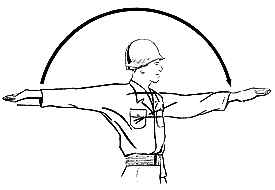 |
 |
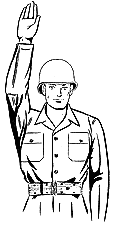 |
| ADVANCE or MOVE OUT. Face the desired direction of movement; hold the arm extended to the rear; then swing it overhead and forward in the direction of desired movement until it is horizontal, palm down. | BY THE RIGHT (LEFT) FLANK. Extend both arms in the direction of desired movement. (Persons, vehicles or craft turn simultaneously.) | HALT or STOP. Raise the hand upward to the full extent of the arm, palm to the front. Hold that position until the signal is understood. |
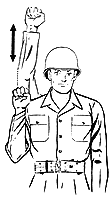 |
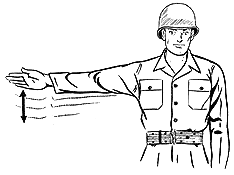 |
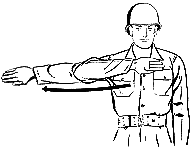 |
| INCREASE SPEED, DOUBLE TIME or RUSH. Raise the hand to the shoulder, fist closed; thrust the fist upward to the full extent of the arm and back to the shoulder rapidly several times. | DECREASE SPEED (vehicle), QUICK TIME (dismounted troops). Extend the arm horizontally sideward, palm to the front, and wave arm slightly downward several times, keeping the arm straight. Do not move arm above horizontal. | MOVE OVER or SHIFT FIRE. Raise the hand that is on the side toward the new direction across the body to the opposite shoulder, palm to the front; then swing the arm in a horizontal arc, extending arm and hand to point to the new direction. For slight changes in direction, wave hand from final position (described above) to the desired direction of movement. |
 |
|
|
| DISPERSE. Extend either arm vertically overhead; wave the hand and arm to the front, left, right, and rear, with the palm toward the direction of each movement. | COLUMN FORMATION. Raise either arm to the vertical position. Drop the arm to the rear, describing complete circles in a vertical plane parallel to the body. The signal may be used to indicate either a troop or vehicular column. Note. When used to designate a rifle squad formation, a supplemental oral command is given. Depending upon the supplemental oral command given, the squad will move in either squad file or squad column, fire teams in column. |
MARCH COLUMN. Raise both arms to a vertical position; describe complete circles by swinging both arms to the rear in vertical planes parallel to the body. Note. When used to designate a rifle squad formation, this signal moves the fire teams abreast. |
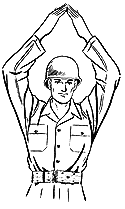 |
 |
 |
| DIAMOND FORMATION. Extend both arms above the head, elbows bent slightly and fingertips touching. | VEE FORMATION. Extend both arms upward and to the sides at an angle of 45 degrees above the horizontal. | WEDGE FORMATION. Extend both arms downward and to the sides at an angle approximately 45 degrees below the horizontal, palms to the front. |
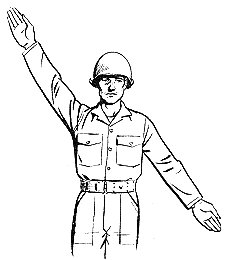 |
 |
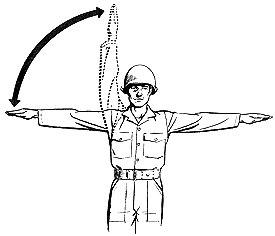 |
| ECHELON RIGHT (LEFT). Extend one arm 45 degrees above and the other 45 degrees below the horizontal, palms to the front. The lower arm indicates the direction of echelon. | LINE FORMATION. Raise both arms to the side until horizontal, arms and hands extended, palms down. | LINE FORMATION, TRAILING FIRE TEAM LEFT (RIGHT). Raise both arms to the side until horizontal; arms and hands extended, palms down. The arm on the side towards which the trailing fire team is to move is swung upward until vertical and then back until signal is completed. |
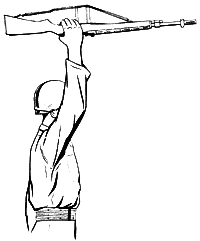 |
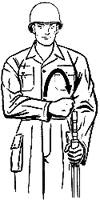 |
 |
| ENEMY IN SIGHT. Hold individual weapon above the head with one arm , fully extended, with the weapon parallel to the ground and pointing in the direction of the enemy. | FIX BAYONETS. Simulate the movement of the right hand in removing the bayonet from scabbard and fixing it on the rifle. | PREPARE FOR ACTION. Raise the fist to the thrust and rotate forearm several times in horizontal, clockwise circles. |
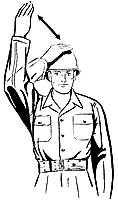 |
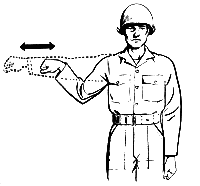 |
 |
| COVER OUR ADVANCE. Strike top of head or helmet repeatedly with open hand. | ACTION FRONT (RIGHT, LEFT, or REAR), FIGHT ON FOOT, or ASSAULT FIRE. Raise fist to shoulder level and thrust it several times in the desired direction of action. | FIRE. Drop the arm sharply from the vertical position to the side. When a single weapon of a group is to be fired, point, with the arm extended, to the particular weapon, and then drop arm sharply to the side. The signal is used as a fire command for large caliber weapons. |
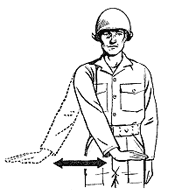 |
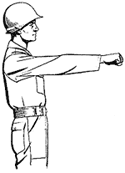 |
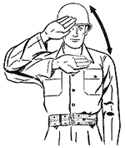 |
| COMMENCE FIRING. Extend arm in front of the body, hip high, palm down, and move it through a wide horizontal arc several times. FIRE FASTER. Execute the signal for COMMENCE FIRING rapidly. For machineguns, this signal indicates a change to the next higher rate of fire. FIRE SLOWER. Execute the signal for COMMENCE FIRING slowly. | RANGE or BATTLESIGHT. Extend the arm forward to the horizontal, fist closed. (This is the signal that range is to be announced. If no other signal follows, the sight setting will be battlesight. Otherwise, show 1 finger for each 100 meters of range to be set on the sights.) | CEASE FIRING. Raise the hand in front of the forehead, palm to the front, and swing the hand and forearm up and down several times in front of the face. |
 |
 |
| MANEUVER RIGHT. Clench fist and thrust in direction of maneuver. | MANUEVER LEFT. Clench fist and thrust in direction of maneuver. |
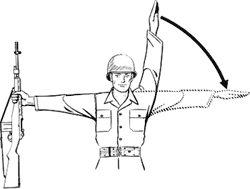 |
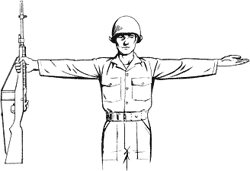 |
| MANEUVER FRONT RIGHT (LEFT) FROM SQUAD COLUMN. Drop arm from the vertical position to the horizontal position in the direction of maneuver | MANEUVER FRONT. |


